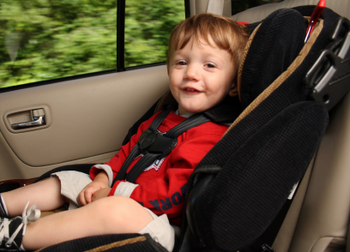
New dataset explores relationship between state and federal child restraint laws.
Fatal traffic accidents killed more than 32,000 people in the United States during 2011. Of those victims, 1,140 were children aged 14-and-younger.
The federal government enacted car seat regulations in 1979 to combat child traffic deaths, and those rules have been effective at reducing child deaths. These regulations require manufacturers to make and sell child restraints that meet certain standards. The National Highway Traffic Safety Administration (NHTSA) has found that child seats “reduce fatal injuries by 71 percent for infants (under one year old) and by 54 percent for toddlers (1 to 4 year olds).”
Federal regulations have been successful because most states incorporate and enforce the national standards. Almost every state relies on the federal regulations by requiring the use of “any appropriate child restraint according to federal regulations.” Studies show that the federal regulations, and the state laws citing those regulations, have directly helped reduce fatal injuries.
Understanding the relationship between state and federal regulation, therefore, is crucial to understanding current car seat rules. Public Health Law Research, a Robert Wood Johnson Foundation program at Temple University seeking to improve public health problems, has just today published a useful dataset that outlines the state laws as they relate to child restraint devices. Strikingly, this dataset details all too clearly the deviations in state law from the requirements of federal regulation.
Ensuring state laws meet minimum federal standards is especially important today in light of impending changes to federal rules. The federal regulations, which are cited by nearly every state in its own child restraint system laws (even if they do not always mirror them), were amended last in February 2012. These recent amendments will take effect in February 2014, and they make three important changes to existing safety standards for child restraint devices, including rear-facing car seats, forward-facing car seats, booster seats, and car beds.
First, the new regulations increase the weight requirements to 36 kilograms, or roughly 80 pounds. The federal regulations currently define a child restraint system as “any device, except Type I or Type II seat belts, designed for use in a motor vehicle to restrain, seat, or position children who weigh 30 kilograms (kg) or less.” The new regulations reflect a 20% increase in the weight requirements.
Second, the new regulations call for more stringent testing and better labeling of child restraint devices. The new regulations are mainly aimed at preventing child head injuries in car accidents, so they specify stricter requirements and procedures for the dummy crash-tests that child restraint manufacturers must perform to test their products. Based on the results of manufacturer’s dummy tests, the manufacturers will be required to place stickers visibly on the device defining the weight and height of a child who could safely occupy the restraint device.
Third, the new regulations recognize the problem of improper use of child restraints in automobiles, which can also lead to death and serious head and bodily injury. The new regulations will require manufacturers to provide instructions for proper use, including the type of vehicles in which the device may be used, the positions and seats in which it may be used, and the possible consequences of improper use.
In these three ways, the federal regulations are intended to improve the safety protection provided by child restraint systems. Companies are required to use very strict testing procedures in order to save the lives of children.
Of course, as in the past, the incorporation of these federal standards into state law will help give these federal changes better applicability throughout the nation. Improving the relationship between federal child restraint regulations and the laws in each state will only enhance the protection of children when they ride in automobiles.
Viren Doshi is a Legal Research Intern at the Public Health Law Research Program at Temple University.



